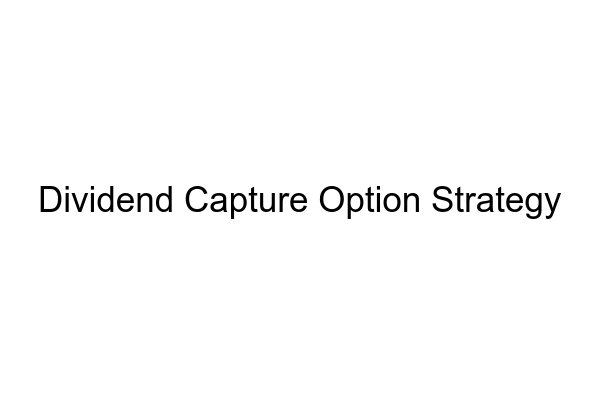Dividend Capture Option Strategy

What are the characteristics of this option strategy?
Dividend Capture Option Strategy is a strategy which seeks to capitalize on stock dividends by selling options prior to the ex-dividend date. By selling options prior to the ex-dividend date, traders can earn a premium by way of capturing the dividend, which would otherwise be paid out to the option owner. This strategy is most effective when the stock has a large dividend payout and when the options are relatively expensive.
Is this a bullish, bearish or neutral strategy?
This is a neutral strategy, as traders are not taking a directional view by selling the options. They are attempting to capitalize on the dividend which would otherwise be paid out, and are not exposed to any market movement.
Is this a beginner or an advanced option strategy?
This strategy is considered intermediate level because it requires knowledge of option pricing and the ex-dividend date of the stock. It is also important to understand the impact of volatility and time decay when trading options.
In what situation will I use this strategy?
This strategy is best used when there is a high dividend yield, the options are expensive and you expect minimal movement in the underlying security.
Where does this strategy typically fall in the range of risk-reward and probability of profit?
This strategy typically has a moderate risk-reward profile with a moderate probability of profit. The risk is limited because the underlying security is not exposed to market movement. The reward is limited because the premium received will be lower than what would be earned by selling the option outright.
How is this strategy affected by the greeks?
This strategy is not significantly impacted by the greeks, since it is a neutral strategy that does not take a directional view on the underlying security.
In what volatility regime (i.e VIX level) would this strategy be optimal?
This strategy is best used when volatility is low, as this allows the trader to receive a larger premium when selling the option.
How do I adjust this strategy when the trade goes against me? And how easy or difficult is this strategy to adjust?
Adjusting this strategy when the trade goes against you is relatively easy. If the underlying security moves higher and the option premium decreases, then you can buy back the option to get out of the position. If the underlying security moves lower and the option premium increases, then you can sell another option to bring your cost basis lower.
Where does this strategy typically fall in the range of commissions and fees?
This strategy typically falls in the mid-range of commissions and fees. Since you are selling the option, you are exposed to commissions when entering and exiting the trade.
Is this a good option income strategy?
This can be a good option income strategy if the underlying security has a high dividend yield and the options are relatively expensive. However, it is important to understand the risk profile of the strategy, as it is limited in its reward potential.
How do I know when to exit this strategy?
You should exit the strategy when it no longer meets your criteria. This could be due to a change in the underlying security’s dividend yield or an increase in implied volatility.
How will market makers respond to this trade being opened?
Market makers will likely respond favorably to this trade since they can use the premium collected from the option sale to partially offset the cost of paying the dividend.
What is an example (with calculations) of this strategy?
For example, let’s assume you are trading MSFT stock which pays a $1.50 dividend. XYZ is currently trading at $250, and you sell a 250-strike call option that expires in 1 month for $5.50. As the option seller, you will collect the $5.50 premium minus commissions and fees. Then, on the ex-dividend date, the stock will move down by the dividend amount, and the option will expire worthless. If the stock rises above $255.50 before the expiration date, the option will be exercised by the buyer, and the option seller (you) will have to sell their stock to the buyer at the $250 strike price minus the dividend of $1.50.
MarketXLS and How it Can Help
MarketXLS is an Excel-based data and trading platform that provides investors and traders with access to accurate and up-to-date stock and option data. With advanced options analysis tools, such as Dividend Capture Strategy, traders can quickly and easily evaluate potential trades and determine their probability of success. MarketXLS can help traders manage risk by allowing them to quickly adjust their trades if the markets shift. Additionally, MarketXLS’ advanced charting capabilities can provide traders with valuable insights into the performance of their trades and help them identify the best entry and exit points for each trade.
Here are some templates that you can use to create your own models
Search for all Templates here: https://marketxls.com/templates/
